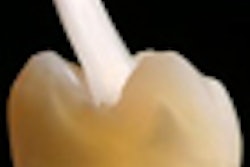
Over the past several years, a variety of self-adhesive restoratives have been introduced, and data about their performance for certain indications are still trickling in.
Now researchers from the University of Athens School of Dentistry and the Center for Dental Medicine at the University of Zurich have compared two self-adhesive materials versus two sealants to see which of them perform best as pit-and-fissure sealants (Dental Materials, July 2013, Vol. 29:7, pp. 752-762).
The researchers tested self-adhesives Vertise Flow (Kerr) and Fusio (Pentron Clinical Technologies); Embrace Wetbond (Pulpdent), a sealant containing hydrophilic monomers suited to moist, acid-etched surfaces; and Helioseal F (Ivoclar Vivadent), a conventional hydrophobic sealant applied to dry, acid-etched surfaces to see how they performed in a lab setting. They found that Helioseal F performed the best or among the best in several categories tested: extent of oxygen inhibition, adaptation, microleakage, penetration, and flow.
Interestingly, in the course of these tests, they also discovered that a procedure with the self-adhesive materials differing from the manufacturers' advised procedure yielded superior results when using them as a sealant.
"Although the self-adhesive restorative materials tested demonstrated increased hardness and better film-forming properties (i.e., curing efficiency and extent of oxygen inhibition)," the researchers explained, "in comparison with conventional sealants, they exhibited poor flow characteristics and inferior fissure-sealing quality, when applied on alumina sandblasted enamel surfaces, as advised by their manufacturers."
In fact, the researchers go on to recommend abandoning the sandblasting step as an enamel pretreatment if the self-adhesive is going to be used as a sealant "since acid-etching of enamel improved the fissure-sealing capacity of the self-adhesive restoratives."
In the course of the study, the researchers tested the materials for the following characteristics:
- Curing efficiency
- Extent of oxygen inhibition
- Flow
- Hardness
- Adaptation, microleakage, and fissure penetration
For curing efficiency, the researchers tested each material in a plastic mold, light-cured them, and analyzed the samples by attenuated total reflectance Fourier transform infrared spectroscopy five minutes after irradiation. Vertise Flow had the highest percentage of degree of cure.
The extent of oxygen inhibition was tested by placing the same volume of each material on individual glass slides. Next, they examined each slide with a light transmission microscope and analyzed their results. They found that Helioseal-F demonstrated the highest value (p < 0.05) but no statistically significant difference among the others.
Flow properties were examined by applying the material to a slide, placing it at an 80° angle, and using a digital caliper to measure how the material behaved before light curing. The self-adhesives were outperformed here; Vertise-Flow showed no flow at all and Fusio's was minimal, the researchers noted. The sealants' performance was better and statistically significant (p < 0.05).
The materials were also placed on a slide during hardness testing. Then the resin-rich layer was removed with a grinding machine, and samples of each material were stored in two settings: one dry and dark, and the other submerged in water. Afterward, the researchers tested hardness with a microhardness tester and analyzed the results. They found differences in hardness after each storage method, but the self-adhesives were significantly harder in both (p < 0.05).
The researchers used extracted, sound premolars for the last series of tests. They proposed two procedures for the self-adhesive materials. In the first, they air-abraded, rinsed, and air-dried the surface. Then the material was applied with the needle application (or microbrush) for 20 seconds into the preparation and light-cured.
In the second procedure, they began the preparation with a nonfluoride, oil-free pumice, rinsed it, and acid-etched with phosphoric acid for 15 seconds. After five seconds of air drying, the sealant was applied in the same way as the previous procedure and light-cured.
For the sealant procedures, the researchers cleaned and rinsed the area, acid-etched, rinsed again, and applied the sealant from cusp to cusp without covering marginal ridges before light curing.
After the samples were sealed with each material, the researchers evaluated them for microleakage under reflected light optical microscopy and scored them. They also evaluated adaptation with environmental scanning electron microscopy, searching for gaps. Fissure penetration also was gauged with a reflected light optical microscope.
Helioseal F had the best adaptation, while the self-adhesives that were air-abraded fared the worst. For microleakage, the results were similar: Helioseal F performed best while the air-abraded self-adhesives had the highest microleakage. Helioseal F also performed better than the other samples in the penetration test, while Fusio performed the worst.
The researchers noted that cleaning steps for self-adhesives advocated by the manufacturers diminished their usefulness as sealants in more complex anatomy, since they're the same as more conventional sealants. However, one method of cleaning proved superior to the other.
"The results of cavity adaptation, microleakage, and fissure penetration testing showed that alumina sandblasting of enamel is an inferior procedure to conventional acid-etching when using the self-adhesive materials as pit-and-fissure sealants," the researchers concluded.



















